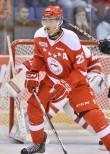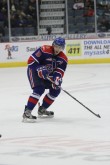They can’t be called fancy stats. At least, not yet, but don’t discount the contextual value in Canadian Hockey League game sheets.
There’s a notable chasm in availability of information in comparison to the NHL. The CHL limitations currently lag advancements being made at the peak of the profession. But that’s not to say there isn’t something to decipher from game sheets.
These expanded statistics focus on 2013 draft-eligible CHLer’s and meant to accompany the release of the McKeen’s top 60 and release of our Draft Guide.
A fully formatted spreadsheet is located here and available for download.
As a standalone element, these expanded stats do not likely carry enough weight to significantly alter any real life draft lists. It could also be a stretch to infer the level influence on a scout’s projection of a player.
A variety of factors cobble the developmental path prospects walk along into their transformation into NHL players. Alone these numbers don’t seem to represent enough of a profile for predictive purposes. (Note** I lack the mathematical sophistication to get deep into formula and predictive models but I’m working on that).
Perhaps this could be a turning point, the onset where data evolves into a stronger symbiotic relationship to scouting views. Another level of sophistication is further testament of use in player assessments.
Technological advancement and expanded statistics strengthen accountability. I feel in the long run, player assessments based solely on eyes will be will be augmented with a statistical factor for accountability, while not reducing the informed influence of scouting opinions. Scouts will likely be required to become better at their craft and perhaps learn new skills, something not required over the course of hockey history, breaking any sense of complacency.
How this affects player projection is an undetermined factor at this point (and with the available information), but with time and further enhancement, statistical accountability has the potential to force a wave of change throughout the scouting world.
Sophisticated hockey operations with viewing information over different periods of the season could meld the numbers together to enhance a deeper projection. In the entwining of two different philosophies, a new model can be born.
There are benefits for media as well, particularly those with extensive beat duties that force attention on immediate matters, rather than following draft eligible prospects. A layer of context benefits their ability to formulate stories and complex questions to ask scouts and prospect experts, for an audience looking for depth to augment their formulation of opinions.
With benefits come pitfalls. Any tossed out bit of information by a member of the media (or blogging world) would be accompanied by a form of accountability.
Still, currently, there are notable gaps. An introduction of shot data would expand the number of events to further sculpt possession profiles.
The expanded stats found in game sheet events add layers of context and can identify undervalued aspects of a player’s performance. Even with the absence of shot metrics, analysis on goals-based data can provide some more context (as we shall see below.)
On a personal level, I find the ability to score – along with the peripheral hockey sense, complimentary skills, etc that make up that ability – outweighs playmaking skills. I weigh a goal scorer higher than a playmaker in most situations (which is out of scope here.)
Anyway, I think I got a little deeper than I expected in this particular introduction, but I will expand further in the near future. Peer review is another element that is important, but hasn't been acknowledged. There is still lots of work to do, but it's one step at a time.
For now, let’s look at some of the goal-based stats available.
There’s enough information to decipher on-ice goals at even strength. This table represents a simple count of the most goals for which a player was on the ice. Nic Petan eclipsed teammate Seth Jones by more than 30 goals. The final column is goals for divided by goals against to give a ratio.

A takeaway is Darnell Nurse and his 72 goals for and 69 against. Rather than focusing on the raw numbers themselves the translation of just how much time he spent on the ice is very evident; and that didn’t include power play time. Some more context? He ranked 10th in penalty minutes (116).
| Player | League | Status | Pos | GP | Goals | OnIceESGF | OnIceESGA | GF/GA |
| Nicolas Petan | WHL | Eligible | C | 71 | 46 | 111 | 46 | 2.41 |
| Seth Jones | WHL | LateBD | D | 61 | 14 | 77 | 35 | 2.20 |
| Dillon Heatherington | WHL | Eligible | D | 71 | 4 | 75 | 51 | 1.47 |
| Matt Murphy | QMJHL | Eligible | D | 69 | 2 | 74 | 50 | 1.48 |
| Madison Bowey | WHL | Eligible | D | 69 | 12 | 73 | 34 | 2.15 |
| Darnell Nurse | OHL | Eligible | D | 68 | 12 | 72 | 69 | 1.04 |
| Anthony Mantha | QMJHL | LateBD | RW | 67 | 50 | 72 | 46 | 1.57 |
| Jonathan Drouin | QMJHL | Eligible | LW | 49 | 41 | 72 | 27 | 2.67 |
| Ryan Hartman | OHL | LateBD | RW | 56 | 23 | 66 | 37 | 1.78 |
| Oliver Bjorkstrand | WHL | Eligible | RW | 65 | 31 | 66 | 25 | 2.64 |

The flip side is On-Ice goals against. Kerby Rychel, who scored 40 goals represented 19.14% of his team’s goals (see below), but similar to Nurse has enough of an on-ice goals against presence to analyze the situation similar to Nurse. As a rudimentary proxy, both players see a tonne of ice time. Naturally, Nurse shows up on this list as well. Vladislav Lysenko is the lone representative of the QMJHL.
| Player | League | Status | Pos | GP | Goals | OnIceESGF | OnIceESGA | GF/GA |
| Kerby Rychel | OHL | LateBD | LW | 68 | 40 | 59 | 77 | 0.77 |
| Trevor Murphy | OHL | Eligible | D | 65 | 9 | 49 | 77 | 0.64 |
| Jared Hauf | WHL | Eligible | D | 72 | 0 | 45 | 77 | 0.58 |
| Jerret Smith | WHL | Eligible | D | 71 | 1 | 45 | 70 | 0.64 |
| Eric Roy | WHL | LateBD | D | 72 | 17 | 44 | 70 | 0.63 |
| Stephen Harper | OHL | Eligible | LW | 67 | 18 | 32 | 70 | 0.46 |
| Darnell Nurse | OHL | Eligible | D | 68 | 12 | 72 | 69 | 1.04 |
| Mason Geertsen | WHL | Eligible | D | 73 | 2 | 39 | 69 | 0.57 |
| Shea Theodore | WHL | Eligible | D | 71 | 19 | 54 | 68 | 0.79 |
| Vladislav Lysenko | QMJHL | Eligible | D | 66 | 7 | 59 | 67 | 0.88 |
A differential works better here. The filter included players that dressed for more than 30 games. From that perspective, the player with the highest goal differential is Nathan MacKinnon, despite only playing 44 games, followed very closely by Jonathan Drouin. To balance the disparity of games played, the last two columns represent values over the course of the regular season. The OHL and QMJHL play 68 games, while the WHL plays 72 games in a season.
Mitch Jones is an interesting outlier.
| Player | League | Status | Pos | GP | Goals | OnIceESGF | OnIceESGA | GF/GA | ESGF/SsnGP | ESGA/SsnGP |
| Nathan MacKinnon | QMJHL | Eligible | C | 44 | 32 | 62 | 23 | 2.70 | 95.82 | 35.55 |
| Jonathan Drouin | QMJHL | Eligible | LW | 49 | 41 | 72 | 27 | 2.67 | 99.92 | 37.47 |
| Oliver Bjorkstrand | WHL | Eligible | RW | 65 | 31 | 66 | 25 | 2.64 | 73.11 | 27.69 |
| Mitch Jones | OHL | Eligible | D | 35 | 0 | 22 | 9 | 2.44 | 42.74 | 17.49 |
| Cole Ully | WHL | Eligible | LW | 62 | 22 | 46 | 19 | 2.42 | 53.42 | 22.06 |
| Nicolas Petan | WHL | Eligible | C | 71 | 46 | 111 | 46 | 2.41 | 112.56 | 46.65 |
| Max Domi | OHL | Eligible | C | 64 | 39 | 59 | 25 | 2.36 | 62.69 | 26.56 |
| Gabryel Paquin-Boudreau | QMJHL | Eligible | LW | 67 | 22 | 59 | 26 | 2.27 | 59.88 | 26.39 |
| Seth Jones | WHL | LateBD | D | 61 | 14 | 77 | 35 | 2.20 | 90.89 | 41.31 |
| Madison Bowey | WHL | Eligible | D | 69 | 12 | 73 | 34 | 2.15 | 76.17 | 35.48 |
| Anthony Duclair | QMJHL | Eligible | LW | 55 | 20 | 52 | 26 | 2.00 | 64.29 | 32.15 |
| Kurt Etchegary | QMJHL | LateBD | C | 31 | 9 | 26 | 13 | 2.00 | 57.03 | 28.52 |
First Assists breakdown of the top three picks reveals almost three times the amount of first assists over second assists for Memorial Cup hero, MacKinnon, and while Jonathan Drouin almost even out, Seth Jones had more second assists in his draft year.
| Player | League | Status | Pos | GP | Assists | A1 | A2 |
| Jonathan Drouin | QMJHL | Eligible | LW | 49 | 64 | 35 | 29 |
| Nathan MacKinnon | QMJHL | Eligible | C | 44 | 43 | 32 | 11 |
| Seth Jones | WHL | LateBD | D | 61 | 42 | 16 | 26 |

Another example of goal-based context is the amount of goals scored during close games, with a team behind by a goal, game tied, or up a goal. This list was pared down to include players that scored 25 or more goals. With that, Vincent Dunn tops that list. Dunn had a birthdate of September 14, 1995, narrowly missing the cutoff for draft eligibility.
Ottawa 67’s Sean Monahan and London Knights Bo Horvat are the lone OHL representatives.
Percentage of Games Close
| Player | League | Status | Pos | GP | Goals | GmCloseGl | %ClGls |
| Vincent Dunn | QMJHL | Eligible | C | 53 | 25 | 12 | 48.00 |
| Jonathan Drouin | QMJHL | Eligible | LW | 49 | 41 | 19 | 46.34 |
| Jaedon Descheneau | WHL | Eligible | C | 69 | 30 | 13 | 43.33 |
| Adam Erne | QMJHL | Eligible | RW | 68 | 28 | 12 | 42.86 |
| Bo Horvat | OHL | Eligible | LW | 67 | 33 | 14 | 42.42 |
| Connor Rankin | WHL | LateBD | C | 71 | 32 | 13 | 40.63 |
| Morgan Klimchuk | WHL | Eligible | LW | 72 | 36 | 13 | 36.11 |
| Laurent Dauphin | QMJHL | Eligible | C | 62 | 25 | 9 | 36.00 |
| Nathan MacKinnon | QMJHL | Eligible | C | 44 | 32 | 11 | 34.38 |
| Sean Monahan | OHL | LateBD | C | 58 | 31 | 10 | 32.26 |

Monahan also scored 15.2% of his team’s goals, while Rychel’s 19.14% led the entire draft class, with Regina Pats Morgan Klimchuk nipping at his heels.
Percentage of Team Goals
| Player | League | Status | Pos | GP | Goals | TeamGoals% |
| Kerby Rychel | OHL | LateBD | LW | 68 | 40 | 19.14 |
| Max Domi | OHL | Eligible | C | 64 | 39 | 14.34 |
| Sean Monahan | OHL | LateBD | C | 58 | 31 | 15.20 |
| Anthony Mantha | QMJHL | LateBD | RW | 67 | 50 | 18.52 |
| Emile Poirier | QMJHL | LateBD | LW | 65 | 32 | 14.88 |
| Curtis Lazar | WHL | Eligible | C | 72 | 38 | 13.72 |
| Hunter Shinkaruk | WHL | LateBD | LW | 64 | 37 | 15.55 |
| Jaedon Descheneau | WHL | Eligible | C | 69 | 30 | 15.08 |
| Morgan Klimchuk | WHL | Eligible | LW | 72 | 36 | 18.85 |
| Nicolas Petan | WHL | Eligible | C | 71 | 46 | 13.81 |
A note that half of this list is comprised of players with late birthdays, after September 15, 1994.
Cory Pronman offered some insight on the effect of late birthdays on statistical models.
@katshockey if you're just building a model to project players based on stats with the same numbers, a Jan 95 is 30% better than a Sept 94.
— Corey Pronman (@coreypronman) May 28, 2013
Our very own Saeed Atcha provided a link to a study on selection bias at the NHL draft. Late birthdays have an impact laid out in this detailed look at the selection process.
@katshockey re: late birthdays. Posted link a couple months ago but you should check it out if you haven't already - goo.gl/Jwhna
— 416_musings (@416_musings) May 28, 2013
This is simply the introduction. There is a ton more to offer and in the coming weeks leading up to the draft, we shall explore this in more detail as time passes.
Follow the McKeen's team on Twitter:
@KatsHockey
@mckeenshockey































